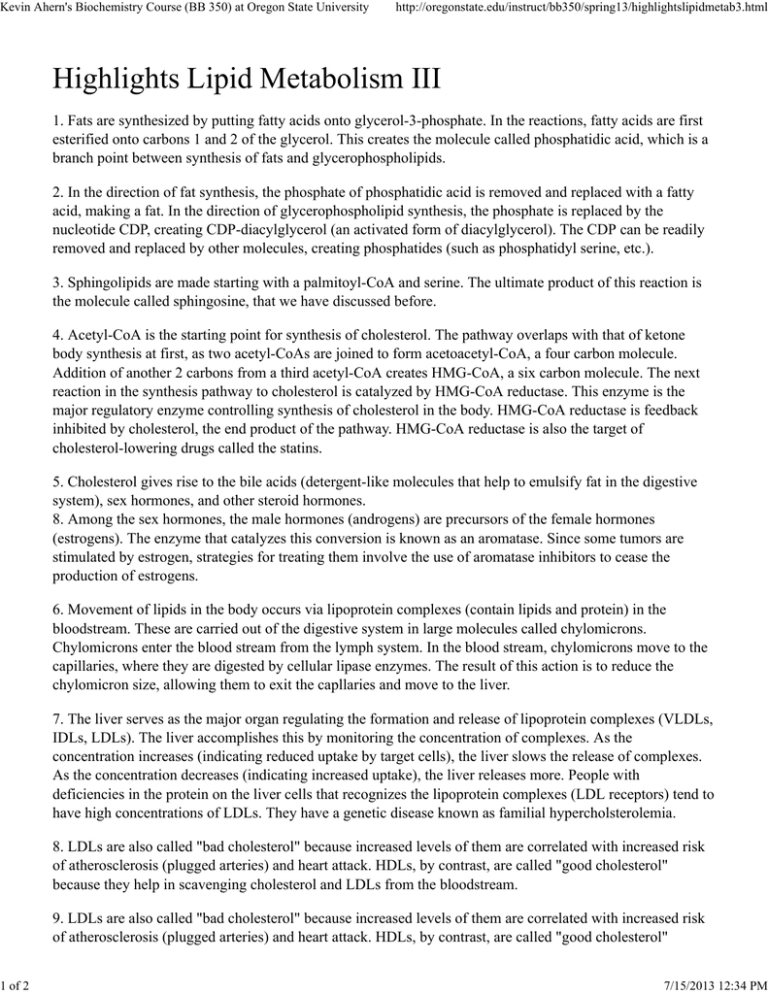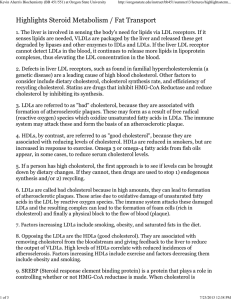Kevin Ahern's Biochemistry Course (BB 350) at Oregon State University
advertisement

Kevin Ahern's Biochemistry Course (BB 350) at Oregon State University http://oregonstate.edu/instruct/bb350/spring13/highlightslipidmetab3.html Highlights Lipid Metabolism III 1. Fats are synthesized by putting fatty acids onto glycerol-3-phosphate. In the reactions, fatty acids are first esterified onto carbons 1 and 2 of the glycerol. This creates the molecule called phosphatidic acid, which is a branch point between synthesis of fats and glycerophospholipids. 2. In the direction of fat synthesis, the phosphate of phosphatidic acid is removed and replaced with a fatty acid, making a fat. In the direction of glycerophospholipid synthesis, the phosphate is replaced by the nucleotide CDP, creating CDP-diacylglycerol (an activated form of diacylglycerol). The CDP can be readily removed and replaced by other molecules, creating phosphatides (such as phosphatidyl serine, etc.). 3. Sphingolipids are made starting with a palmitoyl-CoA and serine. The ultimate product of this reaction is the molecule called sphingosine, that we have discussed before. 4. Acetyl-CoA is the starting point for synthesis of cholesterol. The pathway overlaps with that of ketone body synthesis at first, as two acetyl-CoAs are joined to form acetoacetyl-CoA, a four carbon molecule. Addition of another 2 carbons from a third acetyl-CoA creates HMG-CoA, a six carbon molecule. The next reaction in the synthesis pathway to cholesterol is catalyzed by HMG-CoA reductase. This enzyme is the major regulatory enzyme controlling synthesis of cholesterol in the body. HMG-CoA reductase is feedback inhibited by cholesterol, the end product of the pathway. HMG-CoA reductase is also the target of cholesterol-lowering drugs called the statins. 5. Cholesterol gives rise to the bile acids (detergent-like molecules that help to emulsify fat in the digestive system), sex hormones, and other steroid hormones. 8. Among the sex hormones, the male hormones (androgens) are precursors of the female hormones (estrogens). The enzyme that catalyzes this conversion is known as an aromatase. Since some tumors are stimulated by estrogen, strategies for treating them involve the use of aromatase inhibitors to cease the production of estrogens. 6. Movement of lipids in the body occurs via lipoprotein complexes (contain lipids and protein) in the bloodstream. These are carried out of the digestive system in large molecules called chylomicrons. Chylomicrons enter the blood stream from the lymph system. In the blood stream, chylomicrons move to the capillaries, where they are digested by cellular lipase enzymes. The result of this action is to reduce the chylomicron size, allowing them to exit the capllaries and move to the liver. 7. The liver serves as the major organ regulating the formation and release of lipoprotein complexes (VLDLs, IDLs, LDLs). The liver accomplishes this by monitoring the concentration of complexes. As the concentration increases (indicating reduced uptake by target cells), the liver slows the release of complexes. As the concentration decreases (indicating increased uptake), the liver releases more. People with deficiencies in the protein on the liver cells that recognizes the lipoprotein complexes (LDL receptors) tend to have high concentrations of LDLs. They have a genetic disease known as familial hypercholsterolemia. 8. LDLs are also called "bad cholesterol" because increased levels of them are correlated with increased risk of atherosclerosis (plugged arteries) and heart attack. HDLs, by contrast, are called "good cholesterol" because they help in scavenging cholesterol and LDLs from the bloodstream. 9. LDLs are also called "bad cholesterol" because increased levels of them are correlated with increased risk of atherosclerosis (plugged arteries) and heart attack. HDLs, by contrast, are called "good cholesterol" 1 of 2 7/15/2013 12:34 PM Kevin Ahern's Biochemistry Course (BB 350) at Oregon State University http://oregonstate.edu/instruct/bb350/spring13/highlightslipidmetab3.html because they help in scavenging cholesterol and LDLs from the bloodstream. 2 of 2 7/15/2013 12:34 PM






